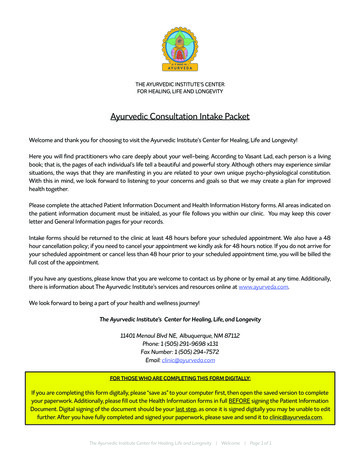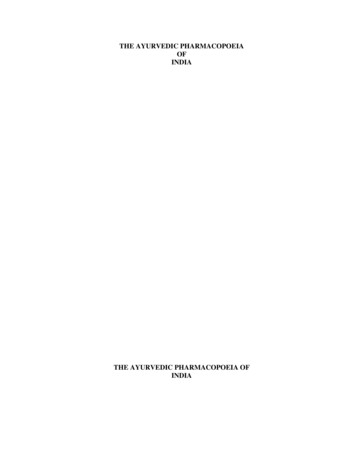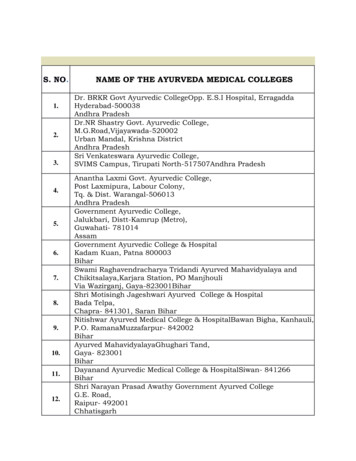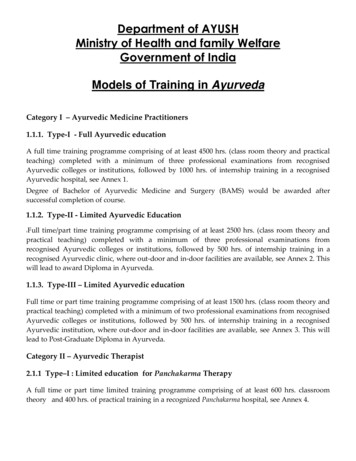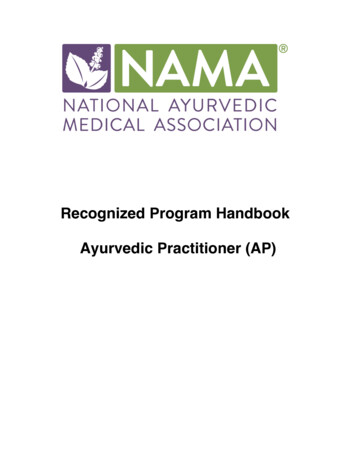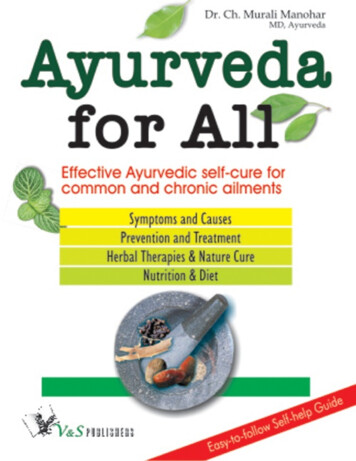
Transcription
Effective Ayurvedic Self-cure for Commonand Chronic AilmentsDr. Ch. Murali ManoharM.D. (Ayurveda)
Published by:F-2/16, Ansari road, Daryaganj, New Delhi-11000223240026, 23240027 Fax: 011-23240028Email: info@vspublishers.comBranch : Hyderabad5-1-707/1, Brij Bhawan (Beside Central Bank of India Lane)Bank Street, Koti Hyderabad - 500 095040-24737290E-mail: vspublishershyd@gmail.com Copyright: AuthorISBN 978-93-8138490-9Edition: April 2011The Copyright of this book, as well as all matter contained herein (including illustrations) restswith the Publishers. No person shall copy the name of the book, its title design, matter andillustrations in any form and in any language, totally or partially or in any distorted form.Anybody doing so shall face legal action and will be responsible for damages.
DedicationThis book is dedicated to my mother Dr. Ch. Jhansi,who has been teaching Ayurveda to me in terms of“Beauty of Living” and to my father, Dr. Ch. RangaRao,who has been teaching Ayurveda to mein terms of “Science of Life”.
Contents1. Ayurvedic Concepts of Health Disease2. Diagnosis by Ayurveda3. Role of Diet in Health & Disease4. Role of Seasons in Health & Disease5. Ayurvedic Concepts of Treatment6. Diseases of the Digestive System7. Diseases of the Respiratory System8. Diseases of the Heart and Circulatory System9. Diseases of the Nervous System10. Diseases of the Urinary System11. Metabolic & Joint Diseases12. Diseases of the Skin & Hair13. Diseases of the Eye14. Problems in Females15. Miscellaneous Problems16. Home (Kitchen) Remedies17. Answers to Your Queries
PrefaceThis book is in your hands because of the three incidents that took placein my life.The first one relates to my father Dr. Chirumamilla Ranga Rao, aneminent Ayurveda physician who has imbibed both science and spirit ofAyurveda (he is currently working for Maharshi Mahesh Yogi’s VedicUniversity and Ayurveda Research Centre, Holland). When I wasstudying Intermediate, an arthritis patient with severe disability wasbrought on a stretcher to his clinic. After visiting several doctorsbelonging to various medical systems, he consulted my father as a lastresort and this was enough to arouse my curiosity to watch his progress.After three months of Ayurvedic treatment, when he started movingabout on his own, I found myself admiring this particular system ofmedicine. Consequently, I appeared for entrance test for B.A.M.S.(Bachelor of Ayurvedic Medicine and Surgery).The second incident as described here prompted me to study Ayurvedamore deeply and empirically. While studying Ayurvedic medicine, I usedto visit my native village on vacations. During one of those visits, Iadvised an elderly neighbour of mine, to stop drinking lest it would ruinhis health. The gentleman, who retired as an army officer, asked mewith a twinkle in his eyes “In my case, I am immune to ill effects ofalcohol. Don’t worry. However, tell me my lad, why some people aremore susceptible to diseases than others? Members of the same familyeat similar food, yet their health is not the same. Some people have goodhabits, still they fall sick easily while some people with bad habits areimmune to diseases. Why is it so?” I had no answer till I entered intofourth year and was taught “Charaka Samhita”. Then I realized thatpeople fall sick not because of bacteria or infection alone, but due tothree main causes namely, Asaatmya indriyaartha samyogam(Incompatible correlation of the senses with their objects),
Prajnaaparaadham (Wrong use of will), and Kaalam (Effect of time).These basic causes upset the fne balance among the bioregulating factorsof the body—Vaata, Pitta and Kapha and make the person fall prey toopportunistic diseases. If one can take care to maintain the balanceamong these bioregulating factors, he is assured of good health. I wentback to my neighbour with this reply, and unfortunately, I found him inthe terminating illness due to alcoholic liver. With great difficulty, hestood up and shook my hand and congratulated me for not merelyparroting the books but trying to analyze things in proper perspective.He added with a wry smile, had I explained him earlier, he would haveprobably taken precautions and averted the disaster.The third incident took place when I was doing my post graduation. Iwas travelling in a train and a fellow traveller asked me, on learningabout my qualification, why anybody should bother about Ayurvedawhen one can guard his health through easily available allopathicmedicines. Then I explained to him that Ayurveda does not confine itselfto treat a disease but goes much beyond. It tells how one has to lead hislife, correlate body and mind, and take precautionary measures toprevent diseases. I told him that it is nature’s prescription to physical aswell as mental diseases that plague a person and that it is ancientwisdom best suited for modern man. At the end of the session, he vowedthat he would opt for Ayurveda. Since I had no better thing to do duringa journey, I could spend enough time to enlighten him. But what aboutthe others who do not have proper idea about so called National MedicalTreatment of this country? I decided to convey the teachings of Ayurvedaby putting them on paper.These three incidents made me think about ways and means to conveythis ancient knowledge to public in a way that was simple and easy tounderstand. Since I believe that more than the foreign systems, Ayurvedais in tune with Indian way of living, I thought it is easy to convince thepublic if written in a native tongue. I discussed the concept with a youngeditor of a popular Telugu weekly and he readily agreed to give me aregular column in his publication, Andhra Jyothi. I must thank late ShriTripuraneni Srinivas, through whom I could enlighten millions ofreaders, through tips and small pieces of information. Then followed myweekly column in Vaartha, a popular Telugu daily, under the supervision
of Shri Jeedigunta Venkata Rao.My writings in Telugu, my mother tongue, got me attention of thelargest circulated English Daily of Andhra Pradesh, Deccan Chronicle andsoon I began writing regularly for them. Most of the articles you aregoing to read in this book were published in that newspaper. Thanks tothe editor Ms. Jayanthi and her team consisting of Ragini, Venu, VeenuLotriya, Margaret, Smitha, and Manjula Murari. I would like to thankMs. Vanaja Banagiri, (Hyderabad Times Times of India), and Mr.Shankar, (Science Express The Indian Express) also. My friend ShriM.B.S. Prasad, an Indo-anglian writer of Telugu origin and ManagingEditor of Haasam, a popular Telugu fortnightly devoted to humour andmusic, gave me some tips to make this book catchy, for which I amobliged to him. I also convey my gratitude to my wife, Smt. Radha forencouraging me in writing this book. Also, to my parents, Dr. Ch. RangaRao and Dr. Ch. Jhansi for their constant guidance.I wish to acknowledge my debt to Shri Ram Avtar Gupta, ManagingDirector of Pustak Mahal, for agreeing to publish the book. But the bookwould not have taken shape if my efforts have not come to the notice ofShri S.K. Roy, Editor of Pustak Mahal. He compiled my articles, edited,and presented them systematically in book form. I am grateful to him.A word for the reader before he proceeds further. This is not atechnical book; it is meant for a layman; an uninitiated reader. That iswhy you do not find in-depth explanation or analysis of basic tenets ofAyurveda here. And, it is in no way a substitute to a qualified doctor.The aim of the book is confined to educate and bring people close toAyurveda.Let me state a fact very clearly at this point. If this book in whatevermeasure benefits you, the credit goes to Ayurveda. If it does not, thefault lies with my communicating skills but not with the science as such.Please let me know what you feel about this book. If you want to knowabout your personal health problem in particular or any clarificationregarding Ayurveda in general, please do not hesitate to write to me. Ishall feel honoured.Shubhamastu. Satamaanam Bhavathi. May you be bestowed with blissand longevity.
Address: Raksha Ayurvedic Centre,—Dr. Chirumamilla Murali ManoharM.D. (Ayurveda)102B, SRK Apartments,Ayurvedic SpecialistOpp. Directorate of Women Development,Yousufguda Main Road, Ameerpet,Hyderabad-500073. A.P.E-mail: muralimanoharch@hotmail.comPhones: (040)3742146, 3756014
1AYURVEDIC CONCEPTS OF HEALTH & DISEASEAyurveda is the science of life or longevity, which helps in thepromotion of health, prevention of diseases and in achieving a long life.The basic philosophy of Ayurveda is based on the panchamahabhoota(five elements) theory. This theory states that the universe as well as thehuman body is made up of five elements, namely air (vayu), space(akash), earth (prithvi), fire (agni) and water (jal). These elementscombine to form controlling forces or biological humours called Dosha.These dosha are responsible for sustaining the living body in its normalstate and are of 3 types: Vaata, Pitta and Kapha.These controlling forces or the doshas act on the tissues of the bodyknown as the Datus and help in the various physiological functions. Thewaste products formed as a result of various bodily functions are Malas,which are end products of the body.Thus the science of Ayurveda deals with Doshas, Dhaatus &Malas.VAATAIt is responsible for active movements of different organs and parts ofour body. There are 5 types of Vaata:1. Praana: Praana refers to functions of the brain and nervous systemi.e. sensations of smell, taste, touch, hearing and vision, movementsof upper and lower limbs, rectum and sex organs and breath.2. Udaana: Udaana refers to movements of the chest, diaphragm andvoice box. It controls movements of breathing out, sneezing andspeech.3. Samaana: Samaana refers to movements of the intestine along withdigestion and absorption of food substances.
4. Apaana: Apaana refers to the movements of the bladder, rectum,uterus and is important for passing urine, stools, menstrual fluids,semen and foetus (delivery).5. Vyaana: Vyaana is concerned with movements of all kinds ofvoluntary and involuntary muscles. It is responsible for movementsof the heart e.g. blood vessels, lymph is a white fluid present indifferent parts of the body) glands and glands which producehormones.The diseases caused by the disorders of Vaata are: Asthma, Epilepsy (fits)and other mental disorders, Urticaria (a skin disease), Viral fever (due totemperature changes), Anaemia (lack of iron in blood), Obesity(increased weight gain), Diabetes, Diarrhoea and constipation Reducedfunctions of thyroid and adrenal glands.PITTAIt is responsible for the chemical reactions that take place in our body. Itis of 5 types.1. Paachaka: Paachaka is due to digestive enzymes and otherchemicals in the body, which control the digestion and absorptionof food substances.2. Ranjaka: Ranjaka is responsible for haemoglobin (the ironcontaining pigment in blood) production.3. Alochaka: Alochaka is responsible for the biochemical activity of theeye, which is responsible for perception of vision.4. Saadaka: Saadaka is responsible for normal functioning of the mind.5. Braajaka: Braajaka is responsible for removing waste products in theform of sweat and enhancing the natural glow of the skin.The diseases caused by disorders of Pitta are as follows: Toxic fevers,Hyperacidity (Gastritis), Vomiting, Diarrhoea, Jaundice, AnaemiaBronchitis, Skin diseases associated with pus formation and All infectionsdue to toxins, bacteria, viruses etc.
KAPHAIt refers to promotion or growth brought about by secretions of differenttypes by the organs. It is of 5 types:1. Kledaka: Kledaka refers to secretions by the mouth, stomach andintestines, which dissolve the food and destroy bacteria.2. Avalambika: Avalambika refers to secretions by the respiratory tractfrom the nose to the lungs and facilitates passing of air and flushesout foreign substances.3. Bodhaka: Bodhaka is the watery secretion of the glands around thetaste buds of the tongue, which help in perceiving the taste.4. Tarpaka: Tarpaka refers to the cerebrospinal fluid which is asecretion surrounding the brain and spinal cord. It providesnutrition to the brain and protects it from toxic substances.5. Shleshaka: Shleshaka is the fluid lying in the bones and joint spacescalled as synovial fluid producing movements of bones and jointswith ease. The watery fluid surrounding and protecting the heartand lungs are also referred to as Shleshaka Kapha.The diseases caused by disorders of Kapha are as follows: Common cold,Infection of the lungs and other parts of respiratory system, Diarrhoeadue to infection, Jaundice, Eczema, Pimples and other skin infections,Arthritis (painful joints), Rheumatic heart disease, Swelling and infectionof the kidneys (glomerulonephritis), Peritonitis (swelling of abdominalcavity), Encephalitis, Meningitis and other infections of the brain and,Benign tumours of different parts of body.DHAATUIt is a substance which is responsible for formation of basic structure ofbody. There are 7 types of dhaatus i.e. lymph, blood, muscle tissue, fattissue, bone marrow, sperm and ovum.MALAS
These are waste products of various dhaatus produced during the courseof metabolic changes in the body. Examples of malas are sweat, urine,stool, gases, bile, earwax, nasal discharge, mucous secretions etc.Thus a disease is due to imbalance of doshas, dhaatus and malas.
2DIAGNOSIS BY AYURVEDADiagnosis of a disease using Ayurvedic methods consists of followingdetails. The two main pillars on which the diagnosis is based are: Historyof illness, and Examination of the patient.HISTORY OF ILLNESSThis refers to the following details:a) Details of the symptoms i.e. how, when where they occur, durationof medicines taken, relieving and aggravating factors etc.b) Past history of similar illness, medicines taken, surgery undergoneetc.c) Personal history i.e. marriage, sexual life, family, occupationalhistory, diet, sleep, bowel movements, smoking, alcohol intake,living conditions, fnancial status, social life and mental status.d) Family history of similar symptoms/illness and treatment taken.EXAMINATION OF THE PATIENTExamination of the patient is done in two steps. First is the generalexamination and second is the examination of the different systems ofthe body.a) General Examination or Ashta Vidha Pariksha: This consists of thefollowing parameters: Examination of the pulse (Naadi Pariksha),Tongue, Urine and stool examination, Speech, Examination bypalpation and percussion, Gait (bodily movement), Generalappearance of the patient, and, Examination of the constitution(Prakriti).
b) Systemic Examination: This consists of examination of thefollowing systems: Digestive system, Respiratory system, Heart andCirculatory system, Nervous system, Urinary system, Musculoskeletal system, Reproductive system, Skin and Hair, and Eyes.Let us know about some important Ayurvedic diagnostic methods.PULSE DIAGNOSIS (NAADI PARIKSHA)Beyond your cells, tissues, and organs, there is an abundance of activityyou are not aware of! It forms complex patterns and is important to yourexistence and can be perceived through the sense of touch. It is yourNaadi or the pulse!If any Ayurvedic doctor, just by touching your wrist, reels off about yourchronic pain or abnormalities in blood sugar and digestion or heartmurmurs or kidney failure or peptic ulcer all without prior knowledge,do not attribute any extra-sensory perception or amazing occult power tohim. It is just an interpretation of a profound theory, the naadi tatvam!MODERN VIEWThe pulse is the pressure wave you can feel as the pumping heart pushesthe blood through the arteries. According to modern medical science, thepulse gives an indication of the rate and pressure at which the heart isbeating and of the pressure at which it is beating apart from the rhythm,character and volume.In a normal individual, normal pulse rate is between 65 and 85,although it tends to be higher in children and the elderly, up to 100 to110 beats per minute. Most of the times, the pulse rate changesaccording to the demand. For example, during and after exercise, therate increases in order to supply the exercising muscles with more bloodand oxygen. However, those who enjoy physical activity often have aslower pulse rate. Just as their body muscles develop and enlarge, sodoes their heart muscle, which as an outcome, becomes betterconditioned and more efficient. Consequently, the rate at which it canperform the job of pumping the blood around the body is slower than it
would be in a less ft individual. The pulse also increases in response tonervous signals and the release of adrenaline like substances into thebloodstream, during psychological stress, excitement or emotion.Abnormally slow pulse: There are a number of medicaldisorders that can slow down the pulse below the normalrate and which, as a result, may also induce palpitations.Medication: Digitalis, the drug that is commonly used tocontrol irregular heart beats, may cause slow pulse. Also,the beta-blockers, such as inderal, atenolol, commonly usedfor a range of disorders including high blood pressure,angina, anxiety, migraine and abnormal rhythms of theheartbeat, also slow the pulse.Hypothyroidism: Low levels of thyroxine, the hormoneproduced by the thyroid gland, causes a pulse rate steadilybelow 60, although in a very ft person the rate could be asslow as 40 (the other symptoms of hypothyroidism includeweight gain, constipation, mental and physical inactivity,lethargy, thinning of hair and dry skin).Heart Block: If your pulse rate is below 60 and physicalstrain makes you feel dizzy and senseless, this suggests aheart block. (The messages transmitted by the conductionsystem of the heart sometimes fail to get through fromtheir source in the upper chambers of the heart to thelower ventricular chambers. As a result, the muscles of theventricles will not contract as often as they should.)Abnormally fast pulse: Tea, coffee and soft drinks, all contain high levelsof caffeine, which is a heart stimulant. So, drinking more than three orfour caffeine containing drinks, or, for that matter, more than two orthree measures of alcohol daily is enough to develop a faster pulse,particularly if the individual is a smoker, since nicotine enhances theeffect.Anaemia: The pulse rate significantly increases in anaemia,a condition in which the oxygen carrying capacity of the
blood is reduced. Anaemic persons look very pale, are oftenshort of breath, particularly during and after physicalwork, and may suffer from angina, since the condition putsmore exertion on the heart. Though the blood carries lessoxygen, the body’s tissues are still in need of the sameamount of oxygen. The heart, therefore, tries to make up inquantity what the blood lacks in quality, beating faster andfaster to re-circulate the blood more quickly so that moreof it goes to the required area.Hyperthyroidism: Just as an under active thyroid slowsdown the metabolism, so an overactive gland, byproducing excess amounts of thyroxine hormone, enhancesmetabolism. This results in rapid pulse. (Associatedsymptoms include diarrhoea, increased appetite, weightloss, flushed, sweaty skin, and generally high energy levels.Palpitation is also a common symptom.)Fever: Most infections, producing a fever, raise the pulserate, and the general rule is ten extra heartbeats per minutefor each one degree Fahrenheit rise in the patient’stemperature. (There are a few exceptions, notably, typhoidfever typically produces a pulse rate slower than would beexpected for the degree of the temperature.)Low Blood Sugar: Low blood sugar is sometimes seen indiabetic patients due to excess of insulin, or missing ameal. The resulting rapid pulse is associated with sweating,behavioural changes, collapse and even coma also.Bronchodilators: Some of the bronchodilator drugs used torelax the airways of asthma sufferers can accelerate theheart rate, especially if excessive doses are taken. Drugsincluded are salbutamol, turbutaline etc. Other medicationscommonly used to treat asthma such as adrenaline,theophylline derivatives may have the same effect.Antispasmodic drugs such as belladonna and byoscinemedications, that relax the smooth muscle of the intestine,produce a rapid pulse rate.
Menopause: Most of the women while passing throughmenopause phase, may notice the hot flushing andpalpitations along with rapid pulse. These are the result ofcirculatory changes caused by hormonal fluctuations.Heart Ailments: For rapid pulse, heart disease is actually arare cause. However, after excluding other general causes,the disorders of the heart valves, conduction system of theheart and heart muscle efficiency are to be considered.Usually there are other, more prominent symptoms thatwould alert patient and doctor to the problem, includingchest pain and shortness of breath, especially when lyingdown, as well as dizziness, loss of consciousness andweakness or numbness in the limbs. In angina sufferers, itis common for the heart muscle to be starved of blood,resulting in chest pain and a rise in pulse rate.Lung Diseases: In the lungs, pneumonia, with or withoutpleurisy, or a blood clot in one of the major veins, canproduce a fast pulse, often with chest pain, fever andbreathlessness as well. With a blood clot, there will also bebloodstained phlegm.Shock: Rapid and weak pulse is a general symptom ofshock. Sudden, severe pain in the abdomen followed bycollapse can be the first sign of a perforated peptic ulcer inthe stomach or duodenum, and would certainly beassociated with rapid pulse.Liver & Kidney Disorders: Malignancies at certain sites suchas liver and kidneys and inflammations of the coveringlayers of the heart, can increase the basal metabolic rate ofthe body and cause a fast pulse often in association withfever, jaundice and loss of weight.AYURVEDIC VIEWAyurveda has got something more than the above general informationabout pulse. According to Ayurveda, every cell in our body sends its own
unique signal to the heart via different vital organs, and the bloodstream. These praanic currents of energy are then compressed intorhythmic pulsation, which can be decoded to reveal what is going on inthe liver or the kidneys, the left ventricle of the heart or the rightfallopian tube. One electro-magnetic wave is all it takes to telecast anentire scene; likewise, our constitution has devised out how to conveythe entire body’s activities through the pulse.The first Ayurvedic classic to describe pulse examination isSaarangadhara Samhita (13th century A.D.). Later works such asBhavaprakasa (15th century A.D.), Yogaratnakara (16th century A.D.),Basavarajeeyam (17th century A.D.) etc. deal extensively with thesubject.The term naadi literally means “a tube or channel through whichsomething fows”. Pulse examination is the examination of the arterialpulses at certain points on the body. The early hours of the morning arethe best times for pulse examination. It can be misleading or incorrect ifdone after the patient has taken food, exercise or bath, after takingintoxicants, having sex, sleep or when afficted with hunger, thirst, anger,grief or worry. The pulse at the wrist on the right hand is selected for themen and on the left hand for the women. While examining the pulse, thepatient is made to sit comfortably, relieved of his or natural urges, andwith faith in the examiner.When an Ayurvedic physician touches your wrist, he probes deep intoyour general state of health, ill health and even the bad prognosis. Asthe strings of a veena bring out all the raagas, so does the naadi. Naadispandana is caused by heartbeats and the consequent movement of rasa(comparable to plasma) and rakta (comparable to blood).Rasa dhaatu is the medium for the tridoshas to circulate all over thebody, their signs being found in the naadi.Proficiency in pulse diagnosis is gained by long practice, alertness andguidance from the preceptor. Though learning to detect disease from thepulse is a skill belonging to the physician, you can also become familiarwith your own pulse and glean fascinating insights into doshas. Onceyou have worked with your doshas you can easily attribute them to prementioned qualities, signs, symptoms etc. of corresponding doshas in the
classical texts. From this data-base, you can gain true intimacy with yourown doshas.HOW TO CHECK YOUR PULSE?To check your own pulse, keep your right arm and wrist slightly flexed.Then see for radial stylus, the bump located outside your wrist bone justunder the thumb. Approach with your left hand from underneath theright hand and move your index finger just below this bump. You willfind the radial artery. Now line up the first three fingers and press downuntil you feel throbbing by all the three fingers distinctly. Then decreasethe pressure of your fingers slightly to sense varying movements of thepulse. These deep and superficial impulses indicate the condition of thetridoshas (three basic metabolic principles which govern the physicochemical and physiological activities of the body in a balanced state anddiseases in a disturbed state), both constitutional and present state in theindex finger they denote vaata in (which controls movement), themiddle finger pitta (responsible for metabolism) and the ring fingerkapha (responsible for body structure). Whichever finger you get aforcible movement, the corresponding dosha is said to be predominant.This examination is better done thrice with few seconds of interval.The various factors to be noted during pulse examination are: pulse rate(spandana sankhya), Character (gati) and Qualities (gunas).As we know, the doshas change all the time; you must be sensitive tomany kinds of variations—your age, season and time of day—all make adifference in your pulse along with all the possible variations in yourhealth. For example, the pulse in the morning is called kapha naadi,which is slow, soft and steady. In the afternoon, it is called pitta naadi,which is warm and unsteady. In the evening, it is the vaata naadi, whichis rapid, feeble in nature. In the same way, during nights the naadi iscalled as sama naadi which will be slow, steady and feeble. Coming tothe seasons, during Varsha (Rainy season; July to September) and Sisira(Late winter; January to March) ritus it is vaata naadi in Sarad (Autumnseason; September to November) and Grishma (Summer season; May toJuly) it is pitta naadi and kapha naadi during Hemanta (Early winter;November to January) and Vasanta (Spring season: March to May) ritus.
There will be pulse variation with the tastes also. After astringent foods,it is hard and feeble and after salty foods, rapid. After exercise, sexualintercourse and fasting, it is rapid and weak. An ideal healthy pulseshould be clearly perceptible (suvyakta), unmixed (nirmala), not veryrapid (amanda) and regular (achanchala).When vaata is predominant in the constitution, the index finger will feelthe pulse strongly. It will be irregular, unsteady, neither hot nor coldand thin, moving in waves like the motion of a serpent.When pitta is predominant in the constitution, the pulse will be strongerunder the middle finger. It will feel active, soft and excited and willmove like the frog’s hop.When kapha is predominant the throbbing of the pulse under the ringfinger is most noticeable. The pulse feels strong, steady, cold, and fulland its movement resembles the floating of a swan.As it happens, all three of these different pulses are present in everyone,but most prominent one signals the particular body type. At times, theremight be a combination of two or all the three doshas which gives amixed picture.BODY CONSTITUTION (PRAKRITI)After knowing your prakriti (body constitution) with the pulseexamination, you can apply it in maintaining the health andcounteracting the disease as it plays an important role in healthplanning. If we know our natural constitution according to vaata, pitta,and kapha, we can take care of our problems and defend againstdiseases. We can know what sort of diseases are possible in us indifferent seasons, and can know how to prevent them before they attackus. It is also possible to perceive about the prognosis of disease withrespect to prakriti.For example, vaata prakriti persons, may suffer from vaata diseases(Eighty in number, mostly the diseases of nerves and bones). if theyindulge more in a cold, dry, rough, bitter, pungent and astringent diet,over exercise, have irregular food habits, live in colder, drier climates.For seasonal consideration cold winter season, pre-rainy season andcloudy, dry windy climates, are not good for them. Illness may worsen if
already present. Any type of sickness may be increased at vaata time,like evening times, late in the night, and the third hour after meals andin old age. If they follow proper diet, behaviour, and tastes to decreasevaata, they may prevent their natural tendency towards the possibility ofvaata type diseases.In case of pitta prakriti, if they tend to indulge in hot, sharp, pungent,sour, salty things, work with fery, acidic substances, they may sufferfrom pitta diseases (Forty in number, mostly metabolic disorders) aspitta tends to aggravate from these causes. Hot climate, autumn, secondhour after meals and midday (noon) and midnight are the specific timeswhen pitta prakriti people’s sickness may increase and medicines takenat this time may be more helpful for speedy recovery.In the case of kapha prakriti, if they indulge more in unctuous, oily,heavy, dull, slimy food substances and eat sweet, sour, salty food, takemore rest and live a comfortable life, with a lack of physical exercise,they may suffer from kapha diseases (Twenty in number, mostlydiseases, concerned with structure), as these causes aggravate kapha.These people may fall sick in the spring, in cold and
Ayurveda is the science of life or longevity, which helps in the promotion of health, prevention of diseases and in achieving a long life. The basic philosophy of Ayurveda is based on the panchamahabhoota (five elements) theory. This theory states that the universe as well as the human body is made up of five elements, namely air (vayu), space
